Archive for July, 2009
Toroidal Number Link
Jul 31st
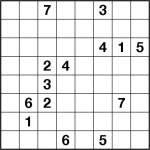
Toroidal Number link 8×8 puzzle
Number Link at sizes up to around 10×10 may not necessarily be hugely challenging for everyone, but I bet you now that this puzzle certainly will be! Despite being only 8×8 it is really very difficult indeed. Or perhaps that’s just me – I’d love to hear that someone finds it easy, but I’m not expecting anyone to!
The rules of this puzzle are, however, very simple:
- Connect each pair of identical numbers with a single line
- Lines can travel horizontally or vertically between squares
- Only one line can enter any square (this means lines cannot cross or overlap in any way)
- Your lines may wrap around from one side of the puzzle to the other, so for example if you travel off the right-hand end of a row then your line will continue on in the left-most square of that row
There is a unique solution to this puzzle, and it uses every square. However, the solution is unique even without the constraint that it uses every square.
If you’ve played toroidal sudoku then you’ll hopefully understand how the wrap around works – when you go off the top of a column you come back on the bottom, and similarly (as stated above) for rows. If the basic rules of Number link itself confuse you, take a look back at a post a few days ago for an example.
And good luck – I think you’ll need it! ![]()
Number Link, Link, Link, Link
Jul 31st
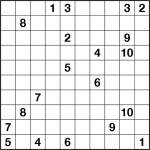
Numberlink 10×10 puzzle 2 (fixed)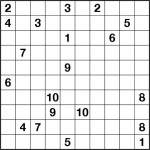
Numberlink 10×10 puzzle 1
When I first tried a Number link puzzle a few years back I didn’t like it at all – it wasn’t immediately clear how to go about solving it, and I didn’t see how I’d ever find it fun. However jump forward to now and I find them really enjoyable, perhaps because it usually is hard to know how to solve them and so you need some fresh thinking each time you try one.
It’s not the only puzzle I’ve had this experience with. There’s a box-shading puzzle called Heyawake that I found horribly mechanical and tedious when I first tried one, probably because at that point I could only tackle the easy ones and so mainly I got stuck when I failed to spot where I could directly apply a solving rule. However a couple of years ago I tried it again and it soon turned into one of my absolute favourites, although it hasn’t quite pushed Nurikabe off its crown of being my personal number one.
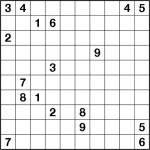
Numberlink 10×10 puzzle 4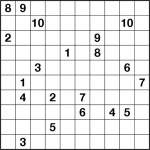
Numberlink 10×10 puzzle 3
It works in reverse too, however. I used to really enjoy Filomino puzzles, but now I mostly find them rather dull – I think that once you get good at certain puzzles you hit a natural wall in difficulty where making them any trickier without requiring what is essentially just guesswork is a real challenge, so you find most puzzles mostly easy. In a great puzzle (like Sudoku), you’ll always find some puzzles tricky no matter how knowledgeable you get, but not all puzzle types behave so gracefully.
The point of all this is that Number link is one of those puzzles that – for me at least – always presents a challenge, and makes me think anew each time I try one. And because it can be infuriatingly tricky it’s also capable of giving me a great deal of satisfaction when I do solve a puzzle.
The Number link examples I’ve posted so far have been pretty easy, so I thought I’d post a few more that were a bit harder. All of these have at least a couple of obvious moves, so it’s certainly possible to make trickier 10×10 puzzles than these, but they do present at least a bit more of a challenge. I’ve arranged them by what I considered increasing order of difficulty, but you may disagree, depending upon how inspired you are as you tackle each puzzle!
The rules are simple: connect each number to its identical partner using only horizontal and vertical lines. Only one line may pass through a square, so lines cannot cross or overlap. There is only one solution. In all of these puzzles the unique solution also uses every square. Both of these last two facts are very useful in narrowing down possible solutions! Take a look at my previous posting for an example solution.
Good luck! ![]()
Edit: The first version of this post included a puzzle (number 2) that had lots of different solutions that didn’t use all squares – I’ve now replaced it with an alternative puzzle. See comments.
Number Link 10×10
Jul 27th
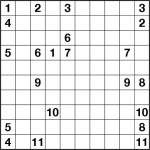
Numberlink 10×10 puzzle 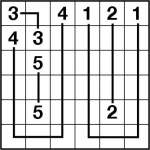
Numberlink example solution
I’ve had a couple of emails and comments suggesting that it would have been easier if I’d included an example with yesterday’s Number Link puzzle, so I’ve made up for that today with both another puzzle (10×10 this time, and not too taxing I hope) and a small 6×6 example of what a finished puzzle would look like: each pair of numbers is linked by a line which travels horizontally or vertically through the squares, and no square is visited more than once (and therefore no lines cross or overlap at any point).
Good luck! ![]()
Number Link
Jul 26th
Over the past few years I’ve made at least one example of pretty much every reasonably popular Japanese number puzzle, but with one notable exception: Number Link. In this puzzle the aim is to draw lines connecting squares with identical values in, but without these lines crossing over or visiting any square more than once. The lines can also only travel horizontally or vertically, not diagonally.
In a completed Number Link puzzle, the lines will be placed such that every square is used – and that solution is guaranteed to be the unique solution too. The rules are not, however, always stated that strongly. In fact the most common form of the rules simply states that you must connect all sets of numbers, with an implied assumption that there is a unique solution, and furthermore again only an implication that that solution uses every square. But in terms of solving the puzzles in practice, it’s fair to assume that:
- There is a unique solution, and that unique solution happens to use every square
This assumption means that whilst solving a puzzle you can make various deductions about how lines can and cannot go based on noting what would make a puzzle non-unique, or not use every square. Once you discard these assumptions (as you need to do when creating the puzzle, since you can’t assume uniqueness without proving it!) it’s typically much harder.
It stands to reason that as puzzles get larger that they can get much trickier, but that isn’t always the case: today’s first example puzzle, whilst quite large at 20×9, is actually really easy, as you’ll probably find out when you try solving it! ![]()
The Little Book of Hard-as-Nails Sudoku 5
Jul 22nd
My new book is out now – The Little Book of Hard-as-Nails Sudoku 5, from Michael O’Mara. It’s available from Amazon UK (link on the right) and, as they say, all other good book stores! (For now, it’s UK only, although importers have listed it on Amazon.com already). It’s part of the Little Book of Sudoku series, thus the number 5 on the cover (although confusingly it’s actually the 6th Little Book of Sudoku, since there was one by another author with the prefix ‘Quick’).
It has 201 puzzles of ever-increasing difficulty, starting at tricky and progressing to insanely hard. They’re broken down into 5 levels, each requiring additional solving skills, but within each level they also get tougher as you progress. Although the puzzles really do get very difficult, they never require ‘unfair’ logic or obscure solving techniques that you’d be unlikely to come up with just on your own. Take a look at my previous posting on hard sudoku for an example – although they get harder than this in the book!
Stepping up – Three-away Sudoku!
Jul 21st
In a possibly inevitable next move (although in this case, I think, a probable conclusion to the theme rather than a stepping stone!) I thought I’d try out Three-away Sudoku, where black markers indicate all neighbouring squares with a difference of 3. With a 9×9 puzzle this still allows somewhat interesting 1-4-7, 2-5-8 and 3-6-9 chains to be used, although of course as you decrease the quantity of numbers that can fit in a chain so you start to lose the longer connected chains which I personally find so interesting.
Other than the three-away markers this is a regular 9×9 Sudoku puzzle, so just place 1 to 9 into each row, column and 3×3 box. Squares with a thick black bar between have a difference of 3 (e.g. 1&4), and those without a thick black bar between have a difference which is not 3.
An idea I have in mind to try next is to mix consecutive and two-away Sudoku in the same grid – I think any other combinations would be too confusing to play, although I suppose you could insert small numbers between squares to show selected differences which might make an interesting but possibly too mechanical variant. For me, I don’t want to have to stop and think about the rules I’m applying – in a good puzzle they should become intuitive really quickly (even if, in some cases, they are a little complex to learn they must become second nature for the puzzle to succeed – or so I find!).
Good luck! ![]()
Two-away Jigsaw 8×8
Jul 20th
Continuing with Two-away puzzles, I thought today I’d post a somewhat smaller challenge – an 8×8 Jigsaw Sudoku version.
The rules are pretty much what you’d imagine: place 1 to 8 into each row, column and bold-lined jigsaw piece. Numbers with a grey bar between them must have a difference of 2 (e.g. 1&3) and numbers without a grey bar between must have a difference that’s not 2. (This is important to ensure a unique solution!)
Good luck! ![]()
Two-away Samurai Jigsaw
Jul 17th
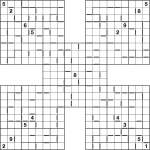
Two-away Samurai Jigsaw puzzle
Here’s a puzzle for the weekend – it’s a 5-grid samurai sudoku where in the corner grids a couple of the 3×3 regions have had their outlines tweaked to turn them into jigsaw sudoku puzzles, with full 8-way symmetry. There are very few givens, which means you’ll need to take full advantage of the two-away markers that are also in the grid. The grey rectangles indicate all neighbouring squares where the difference is 2 (e.g. 1&3 or 6&8) – even without precise values they can also be useful for quickly indicating where a chain of squares are all odd or all even.
Good luck! ![]()
Two-away Samurai Star
Jul 16th
I made this puzzle yesterday but then went and forgot to post it (oops) so I’m making up for that now! It’s a Samurai Star with two-away markers, just as per the previous two puzzles I posted.
Place 1 to 9 into each of the rows, columns and 3×3 boxes of the 5 underlying Sudoku grids (including the one in the centre), whilst obeying the two-away grey bars. Squares with a grey bar between have a difference of 2 (e.g. 1&3 or 2&4), and those without a grey bar have a difference which is not 2.
There are only 4 givens to get you going, so good luck! ![]()
Easy Two-away Sudoku
Jul 9th
I thought that yesterday’s puzzle wasn’t the best example of a new variant, so here’s an easier Two-away Sudoku puzzle. It has a few more connected squares which means the odd/even nature of the puzzle comes through a bit more clearly – if you’re familiar with consecutive sudoku then it probably won’t take you very long to solve.
The rules are as yesterday: place 1 to 9 into each row, column and 3×3 box, and then wherever a grey bar separates two squares the difference must be 2 – they must be “two-away” – and conversely where there is no grey bar then the difference is not 2.
Good luck! ![]()

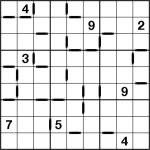
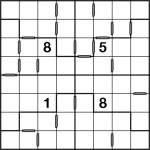
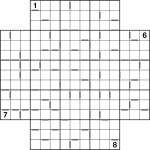
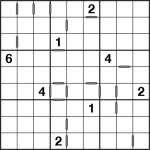

Recent Comments